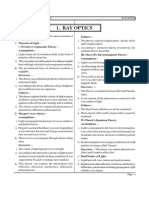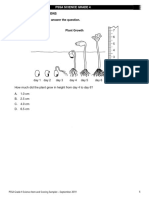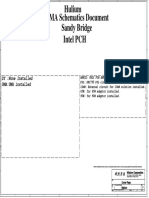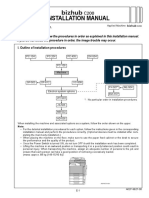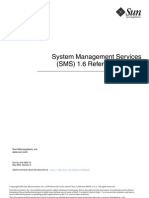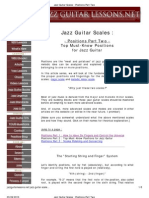Chapter 19 Electromagnetic Waves
Chapter 19 Electromagnetic Waves
Uploaded by
Alicia WilliamsCopyright:
Available Formats
Chapter 19 Electromagnetic Waves
Chapter 19 Electromagnetic Waves
Uploaded by
Alicia WilliamsCopyright
Available Formats
Share this document
Did you find this document useful?
Is this content inappropriate?
Copyright:
Available Formats
Chapter 19 Electromagnetic Waves
Chapter 19 Electromagnetic Waves
Uploaded by
Alicia WilliamsCopyright:
Available Formats
1 ElectromagnetiC Waves
Chapter
9
Whenever there is a live telecast of an event happening on the other side of the
world, one will witness the extensive use of electromagnetic waves in
communication.
Radio waves and microwaves are used for communication between organisers,
reporters and even the coaches. Satellite technology uses microwaves to
transfer live data from one country to another.
While communication is one form of application of electromagnetic waves, the
different characteristics of the various types of electromagnetic waves offer a
wide range of applications.
Chapter 19: Electromagnetic Waves
Electromagnetic Waves
Properties of Electromagnetic Waves:
1. They are transverse waves.
2. They can travel through vacuum at the
speed of 3 x 108 ms-1.
3. They transfer energy from point to
point.
4. They obey the wave equation v = fλ
5. They exhibit wave properties.
Chapter 19: Electromagnetic Waves
(metres)
Radio waves have the longest wavelength while gamma rays have
the shortest wavelength.
Radio waves have the lowest frequency while gamma rays have the
highest frequency.
Chapter 19: Electromagnetic Waves
Chapter 19: Electromagnetic Waves
Radio waves have the longest wavelengths of the
spectrum (10-1 – 105) m .
Source : Radio transmitters and stars
Detector : Radio antennas and radio telescopes
Use : Broadcast, telecommunications, radar
Chapter 19: Electromagnetic Waves
Microwaves have wavelengths between (10-3 - 10-1)m.
Source : Microwave transmitters, stars, magnetron
Detector : Microwave receivers
Uses : Microwave cooking, satellite telecommunications, radar
Microwaves are absorbed by the
water molecules. The energy
carried by the absorbed
microwaves then heats up the food
Chapter 19: Electromagnetic Waves
Radio waves and microwaves are used in telecommunications
Chapter 19: Electromagnetic Waves
Infrared has wavelengths between (10-6 – 10-3) m
Source : All objects emit IR
Detector : Thermocouple
Uses : TV remote control, thermal scanners
Visible light has wavelengths between (10-7 -10-6) m
Source : The sun
Detector : Eyes
Uses : Photosynthesis
Chapter 19: Electromagnetic Waves
Ultraviolet radiation has wavelengths between (10-8 – 10-7) m.
Source : Mercury vapour lamps
Detector : Fluorescent screens dyes
Uses : Forgery detection, sun lamps
X–rays have wavelength between (10-11 – 10-8) m
Source : X-ray tubes
Detector : Photographic film
Uses: Medical inspection, checking welds
Chapter 19: Electromagnetic Waves
Gamma rays have wavelengths between (10-13 – 10-8) m
Source : Radioactive substances
Detector : Geiger-Müller counter
Uses : Cancer treatment, checking welds
Chapter 19: Electromagnetic Waves
Chapter 19: Electromagnetic Waves
Light as a Wave
As mentioned in the previous chapter, the visible spectrum is
only a small component of a large family of waves called the
electromagnetic (EM) spectrum.
Like all EM radiation, visible light exhibits wave characteristics.
Light can be reflected, refracted and diffracted. In a double slit
experiment, light can produce an interference pattern.
However, in 1675, Newton suggested that light was made
up of tiny particles called corpuscles. This is known as the
‘Corpuscular Theory of Light’.
This particulate nature of light contradicts Huygens’
wave theory of light in 1678.
Chapter 19: Electromagnetic Waves
Light as Waves
Huygens’ Construction
According to Huygens’ theory, all points on a wave front act as
secondary point sources.
Basically, if each point of acts as a secondary point source, waves
will arrive from neighbouring points to superimpose constructively to
form the next wave front.
Using Huygens’ wave
construction to show
how plane waves are
formed
Chapter 19: Electromagnetic Waves
Light as Waves
Thomas Young’s Double Slit Experiment
Huygens’ wave theory of light was supported by Thomas Young’s
double slit experiment.
Slits S2 and S3 simulate
the two coherent
sources needed for
interference to happen.
An interference pattern
consists of bands of
bright and dark fringes.
These fringes result
from the superposition.
Superposition is a wave
phenomenon.
Chapter 19: Electromagnetic Waves
Light as Particles
Einstein’s Photoelectric Effect
In 1921, Einstein was awarded the Nobel Prize in physics for his
photoelectric effect experiment.
The results of his experiment could not be explained using the classical
wave theory of light.
Einstein proposed that light existed as packets of light energy (called
photons) which had particulate nature.
His findings led to the acceptance of the dual nature of light, that is, light
exists as waves as well as particles.
Einstein’s photoelectric effect shows that when a metal
surface is illuminated with light of a suitable wavelength,
electrons on the surface of the metal will absorb the
‘packets of energy’ to escape the surface.
Chapter 19: Electromagnetic Waves
You might also like
- Grammar Starter 1Document6 pagesGrammar Starter 1Adelina Voicu75% (4)
- Physics Project Class 12 Wave Nature of LightDocument20 pagesPhysics Project Class 12 Wave Nature of LightVasu20% (10)
- AQA Chemistry Atomic Structure and The Periodic Table KnowIT GCSEDocument86 pagesAQA Chemistry Atomic Structure and The Periodic Table KnowIT GCSEMazanda YalinduaNo ratings yet
- 2 - Oracle CC - B - Algorithm v1.0Document51 pages2 - Oracle CC - B - Algorithm v1.0Akash MathurNo ratings yet
- TDMU LightingEngineering Lecture1 M1.1 Light and RadiationDocument50 pagesTDMU LightingEngineering Lecture1 M1.1 Light and RadiationNguyễn ThịnhNo ratings yet
- Introduction To Spectrochemical MethodsDocument25 pagesIntroduction To Spectrochemical MethodsSİNEM GÜVENNo ratings yet
- Atomic Theory Notes 2019 Answers PDFDocument16 pagesAtomic Theory Notes 2019 Answers PDFJohnNo ratings yet
- 14 - Fundamentals of Physics - Naghi GasimovDocument16 pages14 - Fundamentals of Physics - Naghi GasimovKVP LyricsNo ratings yet
- 2.3 Developments Leading To The Bohr'S Model of AtomDocument29 pages2.3 Developments Leading To The Bohr'S Model of AtomAbijithGamer123No ratings yet
- New Physics ProjectDocument32 pagesNew Physics Projecttusharbhatia2008No ratings yet
- Physical Optics: Theories of LightDocument18 pagesPhysical Optics: Theories of Lightkushwah_770145566No ratings yet
- فيزياءDocument10 pagesفيزياءamanynofal1994No ratings yet
- Chapter 3 Cours 1Document10 pagesChapter 3 Cours 1inessnisrinebenaissaNo ratings yet
- Edoc 2934 1878Document18 pagesEdoc 2934 1878siddheshgadage45No ratings yet
- Class11 Nature of LightsDocument10 pagesClass11 Nature of LightsSyed Muhammad Kaleem UddinNo ratings yet
- Electromagnetic WavesDocument26 pagesElectromagnetic WavesnooneyouknowrnNo ratings yet
- The Photoelectric EffectDocument6 pagesThe Photoelectric Effectapi-644343097No ratings yet
- Lecture 2- Nature & Properties of Light (1)Document53 pagesLecture 2- Nature & Properties of Light (1)mhretabat6No ratings yet
- Handout for QuantumDocument12 pagesHandout for Quantumanduamlakwalelign318No ratings yet
- 7 Types of Electromagnetic WavesDocument2 pages7 Types of Electromagnetic Wavesvee propaganda100% (1)
- Quantum Mechanics - Britannica Online Encyclopedia PDFDocument29 pagesQuantum Mechanics - Britannica Online Encyclopedia PDFMahesh MaheshwariNo ratings yet
- Materi 2 - KF 3Document7 pagesMateri 2 - KF 3Nikita Damayanti SiagianNo ratings yet
- Interference of LightDocument55 pagesInterference of LightFahimul Haque ProttayNo ratings yet
- Quantum Theory and The AtomDocument18 pagesQuantum Theory and The AtomIrish de LeonNo ratings yet
- SEM TEM ChapterDocument22 pagesSEM TEM ChapterFolarin EmmanuelNo ratings yet
- Unit-1 (B - MARCH 2022Document40 pagesUnit-1 (B - MARCH 2022Vibin SimonNo ratings yet
- harshita physicsDocument12 pagesharshita physicsit's LakshyaNo ratings yet
- 1) Wave Theory of Light - PLPN ?Document37 pages1) Wave Theory of Light - PLPN ?vihaann2006No ratings yet
- MODERN PHYSICS 1 Dual Nature and AtomsDocument4 pagesMODERN PHYSICS 1 Dual Nature and AtomsAkash tech. videoNo ratings yet
- Quizlet SpectraDocument2 pagesQuizlet SpectracfmonarquiaNo ratings yet
- PhysicsProject (XII-D) May Help Some Class 12 StudentDocument24 pagesPhysicsProject (XII-D) May Help Some Class 12 StudentArjun SNo ratings yet
- Wave OpticsDocument18 pagesWave OpticsNaveenKumarNo ratings yet
- Chapter - 9 Physical OpticsDocument32 pagesChapter - 9 Physical Opticsbroepic877No ratings yet
- WAVE PROPERTIES OF LIGHT Chapter - 19Document26 pagesWAVE PROPERTIES OF LIGHT Chapter - 19Jon100% (1)
- Cbse Term2 - EmwDocument44 pagesCbse Term2 - Emwvenom eNo ratings yet
- Wave Properties of ParticleDocument35 pagesWave Properties of ParticleAnnida ChairatunisaNo ratings yet
- Dual Nature of Radiation and MatterDocument30 pagesDual Nature of Radiation and MatterArchana ArchuNo ratings yet
- Dual Nature of Radiation and MatterDocument30 pagesDual Nature of Radiation and Matterbhumiharshika2006No ratings yet
- Project on Dual Nature of LightDocument31 pagesProject on Dual Nature of Lighttusharbhatia2008No ratings yet
- Ncert - 8Document3 pagesNcert - 8Sachin KumarNo ratings yet
- Science Quarter 2-Module 2 Electricity and MagnetismDocument81 pagesScience Quarter 2-Module 2 Electricity and MagnetismJazelle Kaye Azupardo100% (2)
- Electromagnetic1 SpectrumDocument6 pagesElectromagnetic1 SpectrumAsumba SteveNo ratings yet
- Wave-Particle Duality of Light TranslationDocument3 pagesWave-Particle Duality of Light Translationxuannghi7701No ratings yet
- ASTRONOMY - Chapter 5 NotesDocument51 pagesASTRONOMY - Chapter 5 NotesJasser ZayyadNo ratings yet
- Chapter 9Document9 pagesChapter 9ahmedbhuttokarachikingsNo ratings yet
- PH1005 Ch1 5 9Document37 pagesPH1005 Ch1 5 9itisfreefireloverNo ratings yet
- Chapter 1-1. Fundamentals of PhotonicsDocument33 pagesChapter 1-1. Fundamentals of Photonicseliassultan3No ratings yet
- Electromagnetic Waves: Description: Electromagnetic Waves Are Formed When An Electric Field ComesDocument14 pagesElectromagnetic Waves: Description: Electromagnetic Waves Are Formed When An Electric Field Comesj_sachin09No ratings yet
- Laporan Unit 3 AyangDocument28 pagesLaporan Unit 3 AyangMurphy LinxNo ratings yet
- Quantum Mechanics Notes-Part 1Document15 pagesQuantum Mechanics Notes-Part 1aman bhatiaNo ratings yet
- Interference of Light (C.D.Mungmode)Document16 pagesInterference of Light (C.D.Mungmode)Sumit MalhotraNo ratings yet
- DOC-20241219-WA0036.Document30 pagesDOC-20241219-WA0036.Mrigank ShekharNo ratings yet
- Lesson-1-Quarter-2-science 10Document40 pagesLesson-1-Quarter-2-science 10ycongryamNo ratings yet
- Optics 1Document5 pagesOptics 1asopNo ratings yet
- History of Light OpticsDocument55 pagesHistory of Light OpticsPARISA IJAZ CH.No ratings yet
- New Microsoft Word DocumentDocument9 pagesNew Microsoft Word DocumentAritra SahaNo ratings yet
- Atomic Structure Live Class-3 Teacher NotesDocument22 pagesAtomic Structure Live Class-3 Teacher Notestarun singh100% (1)
- Integrated Material - Physics Ray OpticsDocument24 pagesIntegrated Material - Physics Ray OpticsSrinivas VakaNo ratings yet
- Physics1101 - Course MaterialDocument332 pagesPhysics1101 - Course MaterialAhmad RazaNo ratings yet
- A Dual Nature of LightDocument2 pagesA Dual Nature of LightRoshdy WaheedNo ratings yet
- ELECTROMAGNETIC FIELDS: Exposure is not optional, no one can avoid itFrom EverandELECTROMAGNETIC FIELDS: Exposure is not optional, no one can avoid itNo ratings yet
- Chapter 01 Fundamental and Derived QuantitiesDocument7 pagesChapter 01 Fundamental and Derived QuantitiesAlicia WilliamsNo ratings yet
- Chapter 06 Linear MotionDocument12 pagesChapter 06 Linear MotionAlicia WilliamsNo ratings yet
- Chapter 04 VectorsDocument9 pagesChapter 04 VectorsAlicia WilliamsNo ratings yet
- Chapter 29 RadioactivityDocument21 pagesChapter 29 RadioactivityAlicia WilliamsNo ratings yet
- Chapter 24 ElectronicsDocument13 pagesChapter 24 ElectronicsAlicia WilliamsNo ratings yet
- Chapter 14 Reflection and Refraction of LightDocument37 pagesChapter 14 Reflection and Refraction of LightAlicia WilliamsNo ratings yet
- Chapter 15 LensesDocument18 pagesChapter 15 LensesAlicia WilliamsNo ratings yet
- Chapter 21 Current ElectricityDocument13 pagesChapter 21 Current ElectricityAlicia WilliamsNo ratings yet
- Chapter 13 Gas LawsDocument14 pagesChapter 13 Gas LawsAlicia WilliamsNo ratings yet
- Review of Well Models and Assessment of Their Impacts On Numerical Reservoir Simulation PerformanceDocument13 pagesReview of Well Models and Assessment of Their Impacts On Numerical Reservoir Simulation PerformanceSheldon HuNo ratings yet
- 1-Electrostatic Forcr Field 2022Document19 pages1-Electrostatic Forcr Field 2022Shamit MNo ratings yet
- Compound Gear TrainDocument3 pagesCompound Gear TrainAlmaas KhanNo ratings yet
- Women in ScienceDocument25 pagesWomen in ScienceJoey BNo ratings yet
- Mathematical InductionDocument24 pagesMathematical InductionJoydeep NaskarNo ratings yet
- MDocument1 pageMlohithsuresh.bNo ratings yet
- PSSA Grade 4 Science Item Sampler 2019-2020 No AnsDocument17 pagesPSSA Grade 4 Science Item Sampler 2019-2020 No AnsSowjanya gudimetlaNo ratings yet
- Aspire S7-191 Wistron Helium UMADocument103 pagesAspire S7-191 Wistron Helium UMAWieslaw ZadenkoNo ratings yet
- Computer Network NotesDocument47 pagesComputer Network NotesSainath Parkar100% (1)
- 5 MATRIKULASI CostingDocument27 pages5 MATRIKULASI CostingpuspaNo ratings yet
- Bizhub c200 InstalacionDocument14 pagesBizhub c200 InstalacioncopiartekNo ratings yet
- SMS 1.6 Reference ManualDocument326 pagesSMS 1.6 Reference ManualStefano GambarèNo ratings yet
- Jazz Guitar Scales PDFDocument7 pagesJazz Guitar Scales PDFrleyens100% (4)
- The Large Mass Method in Direct Transient and Direct Frequency ResponseDocument3 pagesThe Large Mass Method in Direct Transient and Direct Frequency ResponsenetkasiaNo ratings yet
- Analysis On Laptop Using QFDDocument20 pagesAnalysis On Laptop Using QFDWee Soon ChaiNo ratings yet
- University of Nairobi: Photogrammetry Lab ReportDocument4 pagesUniversity of Nairobi: Photogrammetry Lab Report1man1bookNo ratings yet
- MYM7 User Manual-SimpleDocument6 pagesMYM7 User Manual-SimpleANTONIO ROSARIO ESCUDERONo ratings yet
- Grade 10 Questionnaire FinalDocument4 pagesGrade 10 Questionnaire FinalRoselyn OntolanNo ratings yet
- Ngen 2020 v1.1 - Release NoteDocument19 pagesNgen 2020 v1.1 - Release NotePaulus ST., MT.50% (2)
- Layers of The EarthDocument29 pagesLayers of The EarthfloridohannahNo ratings yet
- An Internship Seminar On: "VLSI Design"Document21 pagesAn Internship Seminar On: "VLSI Design"sooraj naikNo ratings yet
- Afm Da40Document508 pagesAfm Da40Marquet ShumateNo ratings yet
- Experiment 3 CHM 432Document7 pagesExperiment 3 CHM 432Amirah NajihahNo ratings yet
- OomdDocument11 pagesOomdAkshay kumar MishraNo ratings yet
- Product Datasheet: Circuit Breaker Compact NSX250F - TMD - 250 A - 3 Poles 3dDocument3 pagesProduct Datasheet: Circuit Breaker Compact NSX250F - TMD - 250 A - 3 Poles 3dReza AgussalimNo ratings yet
- CPDocument5 pagesCPkamran719No ratings yet
- Michel Mendés, Alain Hérnaut - Art, Therefore EntropyDocument4 pagesMichel Mendés, Alain Hérnaut - Art, Therefore EntropyCésar CabreraNo ratings yet

























































